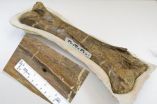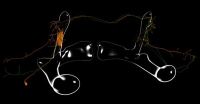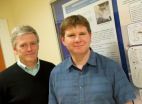(Press-News.org) New research from the University of Adelaide has added to the debate about whether dinosaurs were cold-blooded and sluggish or warm-blooded and active.
Professor Roger Seymour from the University's School of Earth & Environmental Sciences has applied the latest theories of human and animal anatomy and physiology to provide insight into the lives of dinosaurs. The results will be published this month in Proceedings B, the Proceedings of the Royal Society B (Biological Sciences), and can now be found online at: http://dx.doi.org/10.1098/rspb.2011.0968
Human thigh bones have tiny holes – known as the 'nutrient foramen' – on the shaft that supply blood to living bone cells inside. New research has shown that the size of those holes is related to the maximum rate that a person can be active during aerobic exercise. Professor Seymour has used this principle to evaluate the activity levels of dinosaurs.
"Far from being lifeless, bone cells have a relatively high metabolic rate and they therefore require a large blood supply to deliver oxygen. On the inside of the bone, the blood supply comes usually from a single artery and vein that pass through a hole on the shaft – the nutrient foramen," he says.
Professor Seymour wondered whether the size of the nutrient foramen might indicate how much blood was necessary to keep the bones in good repair. For example, highly active animals might cause more bone 'microfractures', requiring more frequent repairs by the bone cells and therefore a greater blood supply.
"My aim was to see whether we could use fossil bones of dinosaurs to indicate the level of bone metabolic rate and possibly extend it to the whole body's metabolic rate," he says. "One of the big controversies among paleobiologists is whether dinosaurs were cold-blooded and sluggish or warm-blooded and active. Could the size of the foramen be a possible gauge for dinosaur metabolic rate?"
Comparisons were made with the sizes of the holes in living mammals and reptiles, and their metabolic rates. Measuring mammals ranging from mice to elephants, and reptiles from lizards to crocodiles, one of Professor Seymour's Honours students, Sarah Smith, combed the collections of Australian museums, photographing and measuring hundreds of tiny holes in thigh bones.
"The results were unequivocal. The sizes of the holes were related closely to the maximum metabolic rates during peak movement in mammals and reptiles," Professor Seymour says. "The holes found in mammals were about 10 times larger than those in reptiles."
These holes were compared to those of fossil dinosaurs. Dr Don Henderson, Curator of Dinosaurs from the Royal Tyrrell Museum in Alberta, Canada, and Daniela Schwarz-Wings from the Museum für Naturkunde and Humboldt University Berlin, Germany, measured the holes in 10 species of dinosaur from five different groups, including bipedal and quadrupedal carnivores and herbivores, weighing 50kg to 20,000kg.
"On a relative comparison to eliminate the differences in body size, all of the dinosaurs had holes in their thigh bones larger than those of mammals," Professor Seymour says.
"The dinosaurs appeared to be even more active than the mammals. We certainly didn't expect to see that. These results provide additional weight to theories that dinosaurs were warm-blooded and highly active creatures, rather than cold-blooded and sluggish."
Professor Seymour says following the results of this study, it's likely that a simple measurement of foramen size could be used to evaluate maximum activity levels in other vertebrate animal groups, both living and fossils.
INFORMATION:
Media Contact:
Professor Roger Seymour
School of Earth & Environmental Sciences
The University of Adelaide, Australia
Phone: + 44 7848 174 350 (Please note: Professor Seymour is currently in Scotland)
roger.seymour@adelaide.edu.au
Holes in fossil bones reveal dinosaur activity
2011-07-10
ELSE PRESS RELEASES FROM THIS DATE:
How memory is read out in the fly brain
2011-07-10
This release is available in German.
What happens if you cannot recall your memory correctly? You are able to associate and store the name and face of a person, yet you might be unable to remember them when you meet that person. In this example, the recall of the information is temporarily impaired. How such associative memories are "read out" in the brain remains one of the great mysteries of modern neurobiology. Now, scientists from the Max Planck Institute of Neurobiology in Martinsried and from the Ecole Supérieure de Physique et de Chimie Industrielles in Paris, ...
Survey Says Drivers Lack Basic Knowledge, Are Dangerous in New Jersey
2011-07-10
All motorists should drive cautiously to avoid crashes on U.S. roads, but drivers in New Jersey have a new reason to be more attentive while driving. A recent insurance company survey rated New Jersey drivers poorly on licensed motorists' responses to typical driver's test questions. While the state has improved its seat-belt use lately and lowered its fatal crash rate last year, New Jersey drivers can still use this current ranking to continue improving driver education and knowledge of basic traffic laws and practices.
Dangerous Conditions
New Jersey roads and intersections ...
Scientists discover how best to excite brain cells
2011-07-10
ANN ARBOR, Mich.---Oh, the challenges of being a neuron, responsible for essential things like muscle contraction, gland secretion and sensitivity to touch, sound and light, yet constantly bombarded with signals from here, there and everywhere.
How on earth are busy nerve cells supposed to pick out and respond to relevant signals amidst all that information overload?
Somehow neurons do manage to accomplish the daunting task, and they do it with more finesse than anyone ever realized, new research by University of Michigan mathematician Daniel Forger and coauthors demonstrates. ...
Study reveals how decision-makers complicate choice
2011-07-10
NEW YORK – July 8, 2011 – A study by Columbia Business School's marketing professors Ran Kivetz, Philip H. Geier, Jr. Professor of Marketing, and Oded Netzer, Philip H. Geier Jr. Associate Professor, Marketing, alongside Rom Schrift, Assistant Professor of Marketing, the Wharton School of the University of Pennsylvania (he received his Ph.D. from Columbia Business School in 2011), demonstrates the existence of "complicating choice" – the process that decision-makers unintentionally initiate when making certain decisions – and the underlying psychological mechanisms that ...
Immigration and Education: The Battle over Funding
2011-07-10
Immigration has always been a hot-button issue in the United States. Many states have started to draft legislation that makes it extremely difficult for people here illegally to receive benefits of any kind. In addition to tough new rules, legislators and other groups have begun to attack or repeal laws already in place that will prevent undocumented immigrants from receiving benefits offered to U.S. citizens.
One of the most pressing controversies deals with the issue of an undocumented immigrant's access to higher education. With many states facing budget deficits, ...
Study demonstrates how memory can be preserved -- and forgetting prevented
2011-07-10
BOSTON – As any student who's had to study for multiple exams can tell you, trying to learn two different sets of facts one after another is challenging. As you study for the physics exam, almost inevitably some of the information for the history exam is forgotten. It's been widely believed that this interference between memories develops because the brain simply doesn't have the capacity necessary to process both memories in quick succession. But is this truly the case?
A new study by researchers at Beth Israel Deaconess Medical Center (BIDMC) suggests that specific ...
Study offers new clues about hereditary spastic paraplegia
2011-07-10
HOUSTON -- (July 8, 2011) -- New research from Rice University and Italy's Eugenio Medea Scientific Institute is yielding clues about hereditary spastic paraplegia (HSP), a group of inherited neurological disorders that affect about 20,000 people in the United States. A study in the July 5 issue of the Proceedings of the National Academy of Sciences offers the first detailed account of the biochemical workings of atlastin, a protein produced by one of the genes linked to HSP.
The primary symptoms of HSP are progressive spasticity and weakness of the leg and hip muscles. ...
More Funding, Attention Needed on Elder Abuse in Connecticut
2011-07-10
According to a report by the Government Accountability Office (GAO), Connecticut ranks poorly in the amount of funding and quality of services it provides to victims of elder abuse.
Connecticut ranks 32nd out of 35 states in the amount of money it provides for adult protective services. It also ranks fifth lowest (out of 26) in the number of "substantiated" instances of elder abuse: only 446 of the approximately 3,800 elder abuse reports filed in 2009 were completely resolved or referred for prosecution.
Reaction to the report has been mixed. Some say the ...
Clyde fish stock at 80-year high -- but most are too small to be landed
2011-07-10
Stocks of seabed-living fish in the Firth of Clyde have reached their highest level since 1927 – according to research by academics at the University of Strathclyde.
However, the report, produced by Professor Mike Heath and Dr Douglas Speirs of the University's Marine Population Modelling Group, shows that while fish are actually more abundant than ever, the majority are too small to be landed.
The findings are part of extensive analysis and contradict previous indications from 2010 that the Firth of Clyde had been so heavily fished that it risked being emptied of almost ...
Communication Breakdowns Can Contribute to Medical Malpractice
2011-07-10
A study published in the Archives of Internal Medicine confirms what medical malpractice attorneys and physicians already suspected: There is a breakdown in the lines of communication between primary care physicians, also called PCPs, and medical specialists that could be putting patients at risk.
The study -- which analyzed data compiled by the 2008 Health System Change Health Tracking Physician Survey -- found a marked difference in how PCPs and specialists viewed the quality of information-sharing going on between them. The lack of accurate, timely communication about ...



